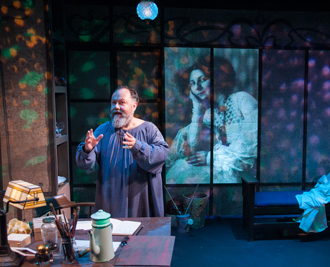
For an artist whose state-sponsored murals were denounced as "pornographic," and who never married (but was rumored to have fathered fourteen children), Gustav Klimt was actually one of the more low-profile members of the nebulous fin de siecle coterie dubbed "Symbolists" by art historians. The contradictions engendered in embracing an aesthetic mandating complete body-and-soul connection with his muse of the moment, while simultaneously subscribing to the Platonic ideal of a single predestined spiritual counterpart for every human being—well, these would be later explained by his Viennese neighbor, Sigmund Freud.
Susan Padveen's The Portrait, shows us the genius at work one afternoon, dressed in his characteristic neglige style, as he sketches—and half-heartedly attempts to seduce—the young model whose fiance he hopes will subsequently commission a portrait of the bride-to-be. Under pressure from responsibilities as the sole support of his many relations and the demands of his latest pregnant paramour, Gustav's thoughts cannot help but turn toward the one woman he truly loves—the fiercely-independent Emilie Flogge, who refuses to give up her career and marry him, but who will remain his lifelong friend—before returning to his immediate tasks.
Modern audiences may experience difficulties accepting this duality. If we believe that Gustav is sincere in his manifesto of the intimacy found only in "complete physical union" ("When two people are united, their happiness is assured. Even God will approve!"), or that his libidinous theories are invoked in order to test his unseen audience's resistance, or that he flirts with her—even to singing Verdi's "Questa Quella" at one point—because his customers expect that kind of patter from their bohemian brethren, our sympathies are guaranteed. On the other hand, the minute we suspect that his pursuit of the innocent visitor is rooted in simple lechery, our disgust at this harassment becomes manifest.
"I had exactly that reaction at an early reading." says playwright Susan Padveen, "One woman said she was attracted to [Gustav], while another said she was horrified by his behavior. I think his intent was only to share an experience that he and his partner would someday recall with pleasure. Klimt engaged in short affairs, not one-nighters. Either way, though, some people will understand—albeit perhaps not entirely appreciate—and some will not."
Cameron Pfiffner, who plays Gustav in the solo play, concurs, "Gustav is crazy about women!" Pfiffner, an artist himself, cites Lithuanian archeologist Marija Gimbutas—credited with discovering a Mother Goddess religion that held sway across Europe for thousands of years before the advent of written history—as the source of his belief that Gustav's claim to love each woman individually echoes these pagan creeds, making his lovemaking almost a devotion.
This is a different eroticism altogether from that practiced by his more notorious associates, Egon Schiele and Oskar Kokoshka. With all the juicy material offered by their autobiographies, why did Padveen choose Klimt to speak to us in 2016?
"In Gustav's society—where just a kiss could constitute a 'love affair'—who would have imagined a time when babies born out of wedlock would be considered normal, where same-sex couples could marry, or gender identity would become a fluid concept?" Padveen reminds us, "Gustav was the beginning of that kind of thinking. His promotion of the individual's right to make his/her own moral decisions and the art reflecting those views, to me, remains very modern. Having your ideas accepted by your contemporaries is a struggle that artists face in every era."
"You see no images of conflict or weapons in any of Klimt's works," adds Pfiffner, "His entire ouvre proclaims, 'Make love, not war'—and isn't that what we need to hear today?"
The Portrait runs through August 14 at the Greenhouse.
Mary Shen Barnidge
Contributing Writer

 Follow Us On Twitter
Follow Us On Twitter